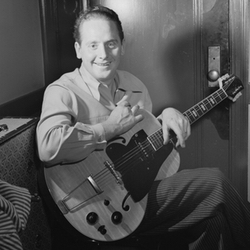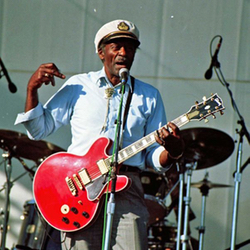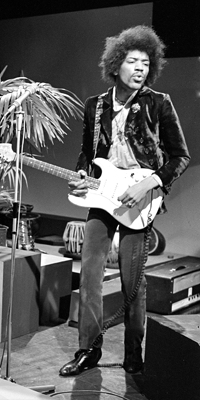Important Figures of the Electric Guitar
The history of the guitar involves many important figures of the electric guitar who have helped define how the instrument is built, designed, or played. While this list could easily be miles long, I've decided to pick some major "players" (both figuratively and literally).
Adolph Rickenbacher & George Beauchamp
Although the first name on the list sounds like he should be famous for making popcorn, Rickenbacher and his partner Beauchamp actually produced the first commercially available electric guitar, an Hawaiian guitar affectionately known as the "frying pan." Although Rickenbacher's name because associated with the company (as Richenbacker), it was actually Beauchamp who secured the patent for the first electric guitar. Regardless, both were important figures of the electric guitar and its early history.
 Famed Musician and Inventor
Famed Musician and InventorLes Paul
Les Paul
Although he is most famous for the Gibson model bearing his
name, Les Paul (born Lester William Polsfus - yeah, you'd change your
name, too) was one of the earliest innovators for the electric guitar.
He also invented multitrack recording. Not too shabby a resumé. Oh yeah,
he could play too, holding weekly gigs in New York well into his 90s.
Leo Fender
Few names are as synonymous with the electric guitar (and amplifiers) as Leo Fender's. Fender originally became part of the music industry through his radio repair shop where he also fixed amplifiers. Eventually, Leo and friends created the first mass-produced electric guitar, the Fender Esquire (later to become the Telecaster). When you add the Stratocaster guitar, Precision and Jazz Basses, as well as amplifiers such as the Bassman, Twin Reverb, and Deluxe Reverb, you've got a legend. After he sold Fender to CBS in 1965, Leo went on to form Music Man and G&L Instruments. Oddly enough, he never learned to play the guitar. Regardless, he is one of the most important figures of the electric guitar and its development.
Ted McCarty
Like his contemporary (and
sometime competitor) Leo Fender, Ted McCarty never learned to play the
guitar, but his contributions to its development are nearly without
peer. While president of Gibson from 1950 to 1966, McCarty oversaw the
development not only of the popular Les Paul solid body, but also that
of the ES-335, SG, Flying V, Explorer, Moderne, and Firebird, as well as
the humbucking pickup and tune-o-magic bridge. He would later develop a
relationship with contemporary guitarist and builder Paul Reed Smith,
who named one of their most popular models after McCarty.
Charlie Christian
Although it's hard to believe, at one point the guitar occupied a very minor role in popular music. This was a matter of necessity more than anything. The guitar itself simply wasn't capable of producing much volume. Of course, that eventually changed. It was Charlie Christian, a Texas-born and Oklahoma-raised, guitar player who changed the perception of what was possible with the electric guitar. As a young black musician from the south, Christian shattered many stereotypes and proved himself a world-class musician while playing with the Benny Goodman orchestra. He died of tuberculosis at the age of 25, but not before becoming one of the most important figures of the electric guitar and its early history.
Chuck Berry
There isn't a rock guitarist who hasn't been influenced by Chuck Berry, who fused sounds of R&B and even country into the new sounds of rock and roll. His shuffle rhythms as well as signature guitar solos on such tunes as "Maybellene," "Roll Over Beethoven, and "Johnny B. Goode." His distinctive guitar playing has influenced everyone from John Lennon and Ted Nugent to Angus Young and Keith Richards, marking him as one of the most important figures of the electric guitar and its impact on rock and roll.
BB King
Not unlike Chuck Berry, every rock guitarist as well as every blues guitarist owes a huge debt to BB King. Along with fellow "Kings" Albert and Freddie (no relation to either), Riley B. King is considered one of the most influential blues guitarists of the 20th century and beyond. His soulful vibrato and tasteful string bending have influenced guitarists who have never even heard his music directly. Known mostly for his version of the tune "The Thrill is Gone" and his guitar Lucille, BB King is a true legend, and his wide influence makes him one of the most important figures of the electric guitar and its impact on blues, R&B, and rock music.
Eric Clapton
With the explosion of rock music in the 1960s, a new more raw sound emerged, that of the singing electric guitar solo, made possible both by advances in guitar gear technology as well as new ways of conceiving the instrument. Few players pushed the boundaries as much as Eric Clapton, who is a major transitional figure from traditional blues to contemporary rock guitar playing. Clapton even helped redefine our understanding of guitar strings for rock players, being one of the first players to use an unwound "G" string to facilitate bending (he appropriated a banjo string for the purpose) and one of the most important figures of the electric guitar due to his fusion of blues and rock guitar.
Jeff Beck
Few players have continued
to evolve and perfect their craft as much as Jeff Beck. One of the major
British players to emerge from the 1960s (along with Eric Clapton and
Jimmy Page), Beck has shown excellence in not only blues and rock but
fusion as well. Rather than rely upon the same rehashed licks, Jeff Beck
has continually pushed the boundaries of his craft. In fact, one could
even argue that his playing has improved in time and with age, which is
unusual given that Beck is currently almost 70 years old (born June 24,
1944). Since the 1980s, he has eschewed the use of a pick, choosing to
coax tone from his signature Fender Stratocaster using his fingers. His
effects are minimal, primarily a wah pedal and some type of distortion
or overdrive. As friend and fellow guitarist Eric Clapton has rightly
said, "With Jeff, it's all in his hands."
Jimi Hendrix
Of
all the rock and blues-rock guitarists to emerge in the last fifty
years, none have redefined the instrument as much as Jimi Hendrix. Born
James Marshall Hendrix, Jimi was originally inspired by blues and
R&B music, although country and even rockabilly were also
favorites. The late 60s were the perfect time for someone as
adventerous as Hendxrix to experiment with the wide varieties of new
sounds available. Typically favoring a Fender Stratocaster (played
upside down, since Hendrix was left-handed), Hendrix relied upon
Marshall amplification and numerous effects devices (including the
wah-wah, fuzz pedal, octavia, and Uni-Vibe) coupled with feedback and
wild whammy bar technique to achieve his signature sound. His frenzied
playing coupled with his fearless electronic experimentation would
forever change the landscape of the electric guitar.
Eddie Van Halen
If Hendrix redefined the electric guitar for the late 60s and 70s, then Eddie Van Halen redefined it for the 80s. Not unlike Hendrix, Van Halen's unique approach to both sound (wild harmonics and whammy bar technique) and technique (while not the first, he popularized two handed tapping) would send many guitarists to the woodshed. Aside from his more popular techniques, he is arguably one of the greatest rock rhythm guitarists of all time and paved the way for hot rodded amplification and guitars for the 1980s and beyond.
Important Figures of the Electric Guitar - Final Words
I know that this list is pretty subjective, though I think most of the above names would be on many people's lists. If you'd like to add a name, please let me know!
Add Your Comments Here!
I'd love for you to be a contributor to SoMuchGuitar.com!
Just fill out the information below to add to this page. I'll be in touch about your submission soon!

